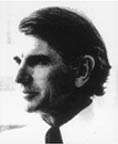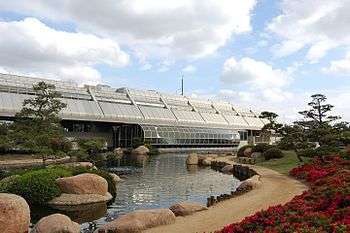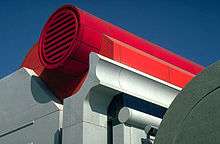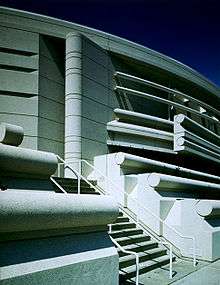Anthony J. Lumsden
Anthony John Hale Lumsden (May 16, 1928 – September 22, 2011) was an American architect most noted for his sculptural and often "futuristic" designs. His projects in Southern California such as the Tillman Water Reclamation Plant are often seen in Hollywood films and televisions shows such as Star Trek Next Generation as part of Starfleet Academy.[1]
Anthony J. Lumsden | |
|---|---|
 | |
| Born | Anthony John Hale Lumsden May 16, 1928 Bournemouth, England |
| Died | September 22, 2011 (aged 83) Los Angeles, California, U.S. |
| Alma mater | University of Sydney |
| Occupation | Architect |
| Spouse(s) | Anne Lumsden |
| Children | 3 |
| Practice | AJLA |
| Website | www |
Biography
Early life
Lumsden was born on May 16, 1928, in Bournemouth, England. He was raised in Sydney Australia, where he went to the University of Sydney architecture school. After graduation, he traveled throughout Europe on motorcycle for a year from Scandinavia to the Mediterranean and settled in London. After a few years there, he was eventually encouraged by a colleague to travel to the United States.[2]
Career

His first job at Eero Saarinen & Associates in Bloomfield Hills, Michigan, was running the blue print machine. He soon got an opportunity to work on a new chapel design for Concordia Senior College and Eero noticed his talent. He quickly became a core member of the design team at the office and met numerous famous designers and artists of the time such as Charles and Ray Eames, Mies Van Der Rohe and Alexander Calder. After Eero's death, he continued to work with Kevin Roche and John Dinkeloo in Hamden, Connecticut. During this period of time he worked on several National AIA award-winning projects such as the General Motors Technical Center.[3]
In 1965, Lumsden and colleague Cesar Pelli left Roche-Dinkeloo to work in California together at Daniel, Mann, Johnson & Mendenhall where Lumsden soon became Principal for Design for the firm and stayed in that position for over 25 years.[4] In the 1970s, many of his designs for rolling glass and steel buildings were published internationally. He was selected as a LA 12 member of the Silver Group, and the LA12 (twelve distinguished architects including John Lautner, Craig Elwood, Frank Gehry, Cesar Pelli, Ray Kappe, organized by California State University, Pomona 1976).[5] In 1979, he was also honored as one of six nationally recognized architects including Michael Graves and James Wines invited to display his work in the Museum of Modern Art for the BEST Showroom Competition in 1979 by Philip Johnson.[6]
Although he worked on hundreds of well known large scale projects including the Moscone Center, Ontario International Airport,[7] and the San Francisco Marriott (famous for its Flash Gordon-like postmodern jukebox shaped tower), his most famous built work is the Tillman Water Reclamation Plant administration building.
Death
Lumsden died of pancreatic cancer in Los Angeles, California, at the age of 83. He was survived by his wife and three children.[8]
Awards and reputation
Lumsden won more than 30 architectural design awards from institutions such as the American Institute of Architects, U.S. Department of Housing and Urban Development, Progressive Architecture, National Society of Professional Engineers, Consulting Engineers Association, Institute of Human Engineering Sciences, and American Institute of Steel Construction. In recognition of the design excellence of his projects and for "the innovation of his design approach," Lumsden was named to the College of Fellows of the American Institute of Architects in the first year of his eligibility.
Leon Whiteson, Architecture Critic for the Los Angeles Times described Lumsden, "In the practice of architecture, it is rare to find a man who is both highly successful and widely respected by his peers. Anthony Lumsden, is that rare man."[9] By the general consent of colleagues and critics ranging from intensely opinionated minds like Britain's Charles Jencks[10] and Reyner Banham to practicing peers like Lou Naidorf, director of design for Welton Becket Associates, Lumsden is one of the best mainstream modernists in America, or anywhere."[11]
Critic and Architectural Historian Professor Kenneth Frampton, Columbia University wrote in SD 1999, "Lumsden remains a man apart on the American scene, today, unsung by the critical establishment but regarded with great respect by those who have a longer aim in view."[12]
Leon Whiteson, architectural critic, wrote in an article for the Los Angeles Times, "The Los Angeles architect with the longest track record and most respected reputation in the design of public projects is Anthony Lumsden".[13]
References
- Masters of Architecture A. J. Lumsden p.104 1997 Images Publishing
- Whiteson, L. "Anthony Lumsden: A Critical View" Masters of Architecture A. J. Lumsden p.9 1997 Images Publishing
- Whiteson, L. "Anthony Lumsden: A Critical View" Masters of Architecture A. J. Lumsden p.9 1997 Images Publishing
- Whiteson, L. "Anthony Lumsden: A Critical View" Masters of Architecture A. J. Lumsden p.9 1997 Images Publishing
- “12 Los Angeles Architects” edited by N. Charles Slert and James R. Harter, Photographic Consultants: Julius Shulman and Marvin Rand, 1978, Cal Poly Pomona
- "MOMA Best design competition" Space Design p.62 July 1979
- Rezendes-Herrick, J. "Designers jazz up ONT terminal" Daily Bulletin p.7 19 April 1996
- Hawthorne, Christopher (October 10, 2011). "Anthony J. Lumsden dies at 83; Southern California architect". Los Angeles Times.
- Whiteson, L. "On Architecture" Los Angeles Times p.21 October 12, 1996
- Jencks, C. Architecture Today p.218 (1988) Abrams Publishing
- Whiteson, L. "Anthony Lumsden: A Critical View" Masters of Architecture A. J. Lumsden p.11 1997 Images Publishing
- Frampton, K. "Sense and Sensibility: Architecture of Anthony Lumsden" Space Design p.49 April 1999
- Whiteson, Leon (May 8, 1994). "Hyperion Plant Proves Essential Public Works Don't Have to Be Boring". Los Angeles Times. p. 22.
Further reading
- Jencks, C. (1988) Architecture Today ISBN 978-0-8109-1883-2
- Images Publishing (1997) A J Lumsden Masters of Architecture Series ISBN 978-1-875498-56-7
- Heyer, Paul (2008) American Architecture ISBN 978-0-471-28529-8
- Sky, Alison (1983) Unbuilt America ISBN 978-0-89659-341-1
- Slert, N. and Harter, J. Photographic Consultants: Julius Shulman and Marvin Rand, "12 Los Angeles Architects" 1978, Cal Poly Pomona

